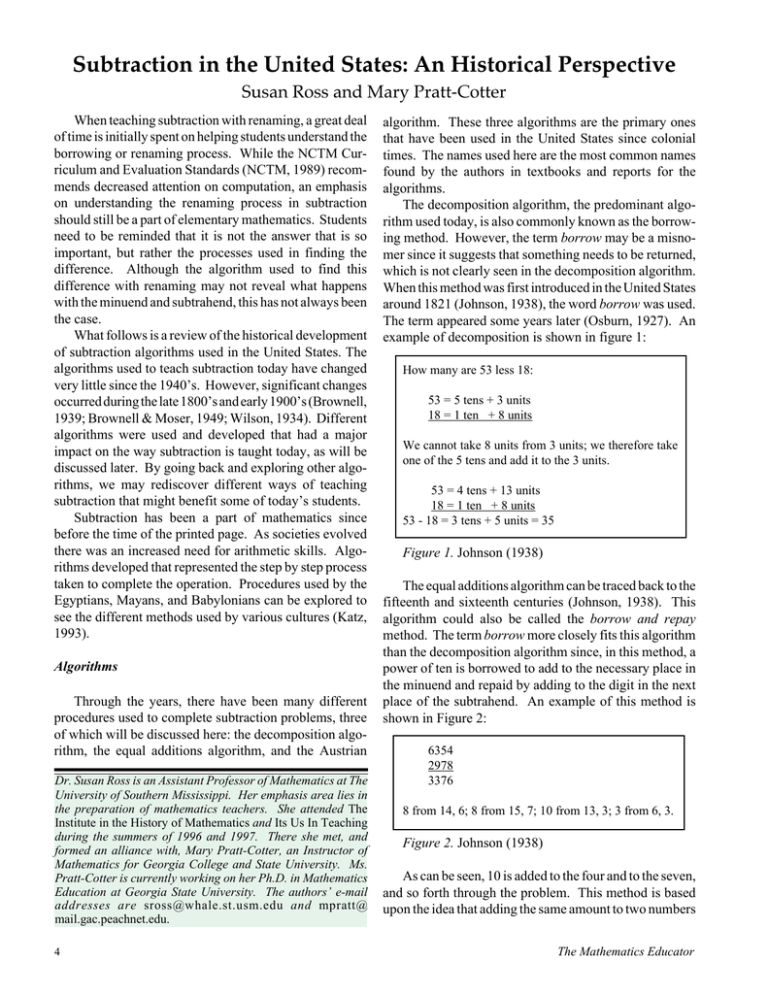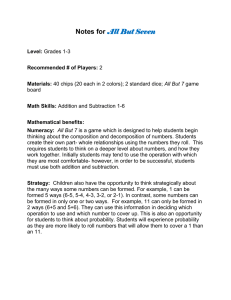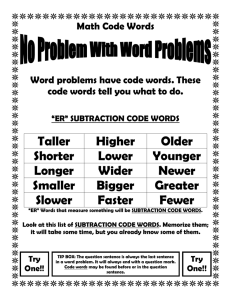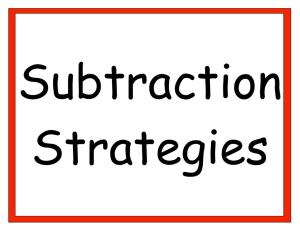Subtraction in the United States: An Historical Perspective
advertisement

Subtraction in the United States: An Historical Perspective Susan Ross and Mary Pratt-Cotter When teaching subtraction with renaming, a great deal of time is initially spent on helping students understand the borrowing or renaming process. While the NCTM Curriculum and Evaluation Standards (NCTM, 1989) recommends decreased attention on computation, an emphasis on understanding the renaming process in subtraction should still be a part of elementary mathematics. Students need to be reminded that it is not the answer that is so important, but rather the processes used in finding the difference. Although the algorithm used to find this difference with renaming may not reveal what happens with the minuend and subtrahend, this has not always been the case. What follows is a review of the historical development of subtraction algorithms used in the United States. The algorithms used to teach subtraction today have changed very little since the 1940’s. However, significant changes occurred during the late 1800’s and early 1900’s (Brownell, 1939; Brownell & Moser, 1949; Wilson, 1934). Different algorithms were used and developed that had a major impact on the way subtraction is taught today, as will be discussed later. By going back and exploring other algorithms, we may rediscover different ways of teaching subtraction that might benefit some of today’s students. Subtraction has been a part of mathematics since before the time of the printed page. As societies evolved there was an increased need for arithmetic skills. Algorithms developed that represented the step by step process taken to complete the operation. Procedures used by the Egyptians, Mayans, and Babylonians can be explored to see the different methods used by various cultures (Katz, 1993). Algorithms Through the years, there have been many different procedures used to complete subtraction problems, three of which will be discussed here: the decomposition algorithm, the equal additions algorithm, and the Austrian Dr. Susan Ross is an Assistant Professor of Mathematics at The University of Southern Mississippi. Her emphasis area lies in the preparation of mathematics teachers. She attended The Institute in the History of Mathematics and Its Us In Teaching during the summers of 1996 and 1997. There she met, and formed an alliance with, Mary Pratt-Cotter, an Instructor of Mathematics for Georgia College and State University. Ms. Pratt-Cotter is currently working on her Ph.D. in Mathematics Education at Georgia State University. The authors’ e-mail addresses are sross@whale.st.usm.edu and mpratt@ mail.gac.peachnet.edu. 4 algorithm. These three algorithms are the primary ones that have been used in the United States since colonial times. The names used here are the most common names found by the authors in textbooks and reports for the algorithms. The decomposition algorithm, the predominant algorithm used today, is also commonly known as the borrowing method. However, the term borrow may be a misnomer since it suggests that something needs to be returned, which is not clearly seen in the decomposition algorithm. When this method was first introduced in the United States around 1821 (Johnson, 1938), the word borrow was used. The term appeared some years later (Osburn, 1927). An example of decomposition is shown in figure 1: How many are 53 less 18: 53 = 5 tens + 3 units 18 = 1 ten + 8 units We cannot take 8 units from 3 units; we therefore take one of the 5 tens and add it to the 3 units. 53 = 4 tens + 13 units 18 = 1 ten + 8 units 53 - 18 = 3 tens + 5 units = 35 Figure 1. Johnson (1938) The equal additions algorithm can be traced back to the fifteenth and sixteenth centuries (Johnson, 1938). This algorithm could also be called the borrow and repay method. The term borrow more closely fits this algorithm than the decomposition algorithm since, in this method, a power of ten is borrowed to add to the necessary place in the minuend and repaid by adding to the digit in the next place of the subtrahend. An example of this method is shown in Figure 2: 6354 2978 3376 8 from 14, 6; 8 from 15, 7; 10 from 13, 3; 3 from 6, 3. Figure 2. Johnson (1938) As can be seen, 10 is added to the four and to the seven, and so forth through the problem. This method is based upon the idea that adding the same amount to two numbers The Mathematics Educator will not affect the difference between the two numbers. Notice that although ten is added to both the minuend and subtrahend, it is the form it takes that is so important. In the minuend, ten is added to the 4 in the ones place, whereas it is added to the 7 in the tens place in the subtrahend. The third algorithm, called the Austrian algorithm, is also known as the additions method. It makes a more clear connection between addition and subtraction than other algorithms. An example is shown in figure 3: 243 To subtract 87 from 243 say: ”7 and 6 are 13; 9 - 87 and 5 are 14; 1 and 1 are 2;” or else say: ”7 and 6 are 13; 8 and 5 are 13; 0 and 1 are 1,” the former being the better. Figure 3. Johnson (1938) In this method, the solution is found by directly relating the answer to addition. The second explanation in the figure is the additive variety of the decomposition method, while the first explanation is known as the Austrian algorithm. Instead of thinking of subtracting 7 from 13 to get the answer, one thinks of what needs to be added to 7 to get 13. This connects subtraction to addition through finding the missing addend instead of focusing on the difference. Illustrated in Figure 4 is one of the earliest uses of the Austrian algorithm in the United States, and was found in a textbook from 1902. From 94,275 take 67,492. 94275 67492 26783 Thus: 2 and 3 are 5; 9 and 8 are 17, carry 1 to 4 as in addition, making it 5, 5 and 7 are 12; carry 1 to 7 making it 8; 8 and 6 are 14; carry 1 to 6 making it 7; 7 and 2 are 9. Figure 4. Wentworth & Smith (1902) The top number is underlined in order to have the form of inverted addition. While the explanation of the process is the Austrian method, the form of the problem is not typical of the algorithm. In most textbook examples, the line is usually drawn under the second number. Travel through time Textbooks from colonial America to the present were explored to identify the rules and algorithms that were used to explain subtraction. Decade after decade, the predominant algorithm used was equal additions. However the decomposition and Austrian algorithms did appear in some textbooks. What follows is a brief survey of the explanations and algorithms found in a variety of textbooks. Volume 8 Number 1 A textbook from 1819 explained subtraction using the following rule: 1. Place the less number under the greater, with units under units, tens under tens, etc. 2. Begin at the right hand and take the lower figure from the one above it and - set the difference down. 3. If the figure in the lower line be greater than the one above it, take the lower figure from 10 and add the difference to the upper figure which sum set down. 4. When the lower figure is taken from 10 there must be one added to the next lower figure. (Willetts, p. 11). As can be seen, the explanation fits the equal additions algorithm since ten is added to the minuend and also to the subtrahend. The following quote is from a handwritten manuscript used by a teacher around 1836. (An exact reference is not known as the cover was missing. The manuscript is part of the private collection of James Wilson at The University of Georgia.) In this manuscript, simple subtraction was described as follows: Place the least number under the greater so that units may stand under units tens under tens and draw a line under them 2 begin at the right hand and take each figure in the lower line from the figures above it and set down the remainder 3 if the lower figure is greater than that above it add ten to the upper figure [italics added] from which number so increased take the lower and set down the remainder carrying one to the next lower number [italics added] with which proceed as before and so on till the whole is finished proof add the remainder to the least number and if the sum be equal to the greater the work is right. Notice that no punctuation was used. As can be seen in the italicized parts, the equal additions method is used to teach subtraction. There was no explanation given to the student as to why the method works or why using this method will give the difference of two numbers. The student was given the rule and a series of examples. The student was then given several problems to work, some of which involved renaming and some that did not. The manuscript was more of a copybook than a textbook. The student would get the book from the teacher and copy the problems onto his slate or paper and then work the problems. As a result, since the student did not have continuous access to the book in order to reread the rule, he 5 or she had to memorize the rule in order to complete the assignment. This is quite different from books used today where the student has constant access to the textbook. Practical Arithmetic by Induction and Analysis (Ray, 1857) also used defined rules. All of the rules for subtraction are developed in a few pages. Basic subtraction facts such as 7-1 = 6 are given on one page in table form, then two pages later, subtraction with borrowing is defined and examples given, as shown in figure 5. This is very different from today where students are typically introduced to basic facts in one grade level and then taught subtraction with renaming in a different grade. It may be two years before these concepts are both presented as opposed to two days. From 73 subtract 45 T. U. 7 3 45 Dif. 2 8 tens 6 4 2 units 13 5 8 SOLUTION - Here, 5 units can not be taken from 3 units. Take 1 (ten) from the 7 (tens), and add this 1 (ten) or 10 units to the 3 units, which will make 13 units in units place; then, subtract the 5 units, and there will remain 8 units, to be put in units’ place. Since 1 ten is taken from the 7 tens, there remain 6 tens in the tens’ place. Subtract 4 tens from 6 tens and put the remainder in tens’ place. The difference of the two numbers is thus found to be 2 tens and 8 units, or 28. Figure 5. Ray (1857) As can be seen, the decomposition method is used at this point in the textbook. However, on the next page, subtraction is also defined using the equal additions method. This is followed by problems to be worked using both algorithms. It would be interesting to know if children were confused by the two methods being presented so closely together. However, so far, no evidence has been found of such an investigation. It is also interesting that mental arithmetic was encouraged. “When numbers are small, the difference between them may be ascertained in the mind; when large, the operation is most easily performed by writing them” (Ray, 1857, p. 28). Standard Arithmetic (Milne, 1895) was structured similar to the text just described (Ray, 1857). Basic facts for subtraction are given immediately followed by examples of subtraction problems requiring renaming. However, in this textbook, only the decomposition method is used. The rule is stated as follows: Rule - Write the subtrahend under the minuend, units under units, tens under tens, etc. Begin at the right and subtract each figure of the subtrahend from the corresponding figure of the minuend, writing the result be6 neath. If a figure in the minuend has a less value than the corresponding figure in the subtrahend, increase the former by ten, and subtract; then diminish by one the units of the next higher order in the minuend, and subtract as before. Proof - Add together the reminder and subtrahend. If the result is equal to the minuend, the work is correct. (Milne, 1895, p. 47). Subtraction with zeros was handled separately in this book. The explanation given for the problem 9000 - 7685 describes the decomposition method: Since five units cannot be subtracted from 0 units, and since there are no tens nor hundreds, 1 thousand must be changed into hundreds, leaving 8 thousand; 1 of the hundreds must be changed into tens, leaving 9 hundreds and 1 of the tens into units, leaving 9 tens. The expression 8 thousand, 9 hundreds, 9 tens, and 10 units is thus equivalent to the minuend, from which the units of the subtrahend can be readily subtracted. (Milne, 1895, p. 49). The books also differed in the number of exercises given. Practical Arithmetic by Induction and Analysis (Ray, 1857) provided approximately 35 problems for practice with basic facts and for practice in using the two methods of subtraction. The book did not specifically state which algorithm to use in the practice problems. However, Standard Arithmetic (Milne, 1895) provided around 100 problems for the same practice using only the decomposition algorithm. During the early to middle 1900’s, examples could be found where different textbooks used any combination of the three different algorithms for teaching subtraction. However, the algorithms that were used did not show any marking through or numbers being rewritten. The students were expected to use mental calculations, writing only the resulting difference. The written work illustrated the answer only. One such example is shown in Figure 6: 723 Since we cannot take 7 from 3, we change one of the 487 2 tens in 723 to units. We then have 13 units - 7 units 236 = 6 units. Since we cannot take 8 tens from the 1 ten remaining in 723, we change one of the hundreds in 723 to tens. We then have 11 tens -8 tens = 3 tens. Since we have used 1 hundred of the 7 hundreds, we have 6 hundreds - 4 hundreds = 2 hundreds. Therefore the difference is 236. Figure 6. Wentworth & Smith (1915) All of this was to change. In November 1937, William A. Brownell conducted a study to determine if a “crutch” in the algorithm of subtraction problems was beneficial. The Mathematics Educator The crutch involved marking through numerals from which an amount was borrowed in order to keep track of the different steps when working a problem. Only one example was found, from a text published in 1857, where markings were used to keep track of the renaming process. This was done in only one problem in the text, with all other problems worked without any markings. Brownell did not indicate that he had knowledge of this example, and claimed the crutch was his own. There was no evidence found that indicated the crutch was being used when Brownell conducted his research on its effectiveness, so it is reasonable to assume that the crutch was his own invention. The crutch was used on decomposition problems, as illustrated in Figure 7. 7 86 39 47 The child will be allowed to mark through the eight and place seven above it in order to keep track of the borrowing instead of having to remember the process through the entire problem. Figure 7. Brownell (1939) Brownell’s study found that, in general, the crutch was beneficial to the students using it. The students using the crutch were more accurate in the early stages as well as the late stages of learning to borrow. Their speed in working the problems was better at the beginning of the study as compared to the students not using the crutch. Toward the end of the study, there was not as much difference in speed between the students using the crutch and those not using the crutch. This crutch caught on very quickly, as can be seen from the example in figure 8: H T O 5 14 12 6 5 2 -4 8 6 1 6 6 minuend subtrahend difference Figure 8. Buswell, Brownell, & John (1947) From then on, most textbooks used the decomposition method for describing borrowing in subtraction, and the use of the crutch described by Brownell became very popular. Today this method of subtraction is used in most textbooks that teaches subtraction. While some textbooks may present alternative algorithms for subtraction, the decomposition algorithm is considered the primary algorithm in the United States. Regardless of the popularity of the new form of the decomposition algorithm, there was some debate over its use. One argument was that the crutch would be detrimental to students because they would not be required to Volume 8 Number 1 remember as much. It would make the work too easy, and the students would not learn as much. Also, students using the crutch would not understand the process of subtraction. From a present day standpoint, these arguments could still be made. In particular, students may be able to accurately complete the subtraction algorithm without fully understanding the process of subtraction. One could counter by stating that the standardization of the crutch helped remove some of the memorization that had been necessary and helped students work the problem more swiftly and more accurately. It is interesting to note how quickly and thoroughly Brownell’s crutch, used in the decomposition algorithm, became the primary algorithm used for subtraction. This could possibly be because of the ease with which the crutch could be modeled using manipulatives, or because of the decreased emphasis on memorization. It is not clear why the crutch caught on so quickly. Almost every textbook seen after his report used the altered decomposition algorithm. The equal additions algorithm and the Austrian algorithm all but disappeared from textbooks. The examples in figures 9-15 (at end of article) were found in textbooks published in different decades. The examples illustrate the widespread use of Brownell’s crutch. Controversy During the early 1900’s, there was a dispute among mathematics educators over which subtraction algorithm to use in the elementary schools. There were several studies conducted to try to determine if one algorithm was better than another. In 1913, the board of education for New York City, and in 1919, the board of education for San Francisco both mandated the use of the Austrian method for teaching subtraction. It is not clear how effective the mandates were. Many teachers continued to use methods other than the Austrian method, and those that did use it did not show significant improvement in their students’ performance. One study found that only a little more than one third of the children in New York City used the “sanctioned” method (Osburn, 1927, p. 241). Other studies were also conducted. In 1914, before the introduction of the crutch, P. B. Ballard conducted an experiment in England exploring the three algorithms. Ballard found that the equal additions method was superior to the decomposition method (Osburn, 1927). Similarly, in 1918, W. W. McClelland compared the equal additions method and the decomposition method and concluded that the complete result of the comparison of the two methods may thus be summarized by saying that the method of equal additions appears superior in speed, accuracy, and adaptability to new conditions, while the method of 7 decomposition is superior in speed after long practice. (Osburn, 1927, p. 239) Also, a study by Johnson (1938) found that the decomposition method was not as successful as the other methods. Again, this study was conducted before the introduction of the crutch. It is interesting to note that in spite of all the early studies, a nationwide survey conducted by Guy M. Wilson (1934) found that the decomposition algorithm was used two and a half times as often as the equal additions algorithm. The arguments in favor of the direct method are (1) that it forms a true association with the real meaning of subtraction, (2) that it keeps the process of subtraction separate and distinct from the process of addition, (3) that borrowing is more easily rationalized than carrying, (4) that fractions are more easily subtracted by the direct method than by the additive method. The arguments in favor of the additive method are (1) that it provide economy of learning because the bonds are so similar to those that were used in addition, (2) that it gives no special difficulty when there are successive zeros in the minuend, as does the direct method. (Clark et al., 1939, p. 23) Preservice Education In a textbook for preservice teacher education, Morton (1927) discussed the three different algorithms and gave advantages and disadvantages for each. While not advocating one method over the other, he did indicate a personal inclination for the decomposition method. His recommendation to prospective teachers reading his book was one of laissez-faire; do not attempt to change what the majority of the people use in the school where you teach. Examples given in his book used the decomposition method. On the other hand, Stone (1925) strongly recommended the additive approach, or the Austrian algorithm, to subtraction in his book to preservice teachers. In reference to the problem 82 - 27 = 55, he explained: Since 2 is less than 7, take 1 of the 8, making 1 ten and 2 or 12. 7 and 5 are 12, write 5. Since 1 of the 8 has been taken, 7 remain. 2 and 5 are 7, write 5. Thus it is seen that the method shown here is a combination of both the “taking-away” method and the “addition” method. No teacher can hope to teach such a method successfully or to develop much skill when using it. The pupil should be taught to think, “7 and 5 are 12, write 5; 1 to carry and 2 are 3, and 5 are 8, write 5.” (pp. 96-97) Stone strongly preferred the additive method over the decomposition method. Note that both Stone (1925) and Morton (1927) were published around the same time, and yet there is a difference in the recommendations made by the authors. This is not necessarily surprising given that all three algorithms were being used in textbooks at this time. The debate continued into the 1930’s. Clark, Otis, and Hatton (1939) gave two methods of subtraction. The decomposition method was named the direct method and the equal additions method was named the additive method. However, the argument for the two methods were familiar. 8 The methods books used for the teaching of elementary teachers also made a change during the five to ten years after Brownell’s crutch was introduced. In Teaching Arithmetic for Understanding (1958), the decomposition method and the equal addition method were taught. The students were told that the decomposition method is the most common method in use but that they should be aware of both. The algorithms for the two methods are described using marks to illustrate action taken in the algorithm. Figure 14 illustrates the decomposition method and Figure 15 illustrates the equal additions method (the earliest example of this method found by the authors). In contrast, Eicholz, O’Daffer, Brumfiel, & Shanks (1964), published a methods book in which they did not mention the equal additions method. The decomposition method was described in detail and Brownell’s crutch was seen in the algorithm. In the 1960’s, the School Mathematics Study Group published a textbook series for the elementary grades, where the focus was on the use of place value. Numbers were written in expanded form and used to explain the subtraction process and algorithm. When subtraction requiring regrouping is first introduced, an abacus is used to illustrate the renaming along with writing the number in expanded form. This process was then very quickly shortened into the algorithm using the crutch. Very little actual change was made in teaching subtraction in spite of the emphasis on place value. The decomposition algorithm was still utilized. The algorithms and language used to describe subtraction have changed since colonial times. One of the most dramatic changes in algorithms seen in this century was the introduction of Brownell’s crutch. This new version of the decomposition algorithm has so completely dominated the field that it is rare to see any other algorithm used to teach subtraction today. The Mathematics Educator Figure 9. Wheat & Heard (1959) Figure 10. Buswell, Brownell, & Sauble (1963) Figure 11. Eicholz, O’Daffer, Brumfiel, & Shanks (1964) Figure 12. Eicholz, O’Daffer, & Fleenor (1981) Volume 8 Number 1 9 Figure 13. Vogel, et al. (1981) Figure 14. Marks, Purdy, & Kinney (1958) Figure 15. Marks, Purdy, & Kinney (1958) 10 The Mathematics Educator References Milne, W. J. (1895). Standard arithmetic. New York: American Book Company. Brownell, W. A. (1939). Learning as reorganization: An experimental study in third-grade arithmetic. Durham, NC: Duke University Press. Morton, R. L. (1927). Teaching arithmetic in the primary grades. New York: Silver, Burdett and Company. Brownell, W. A., & Moser, H. E. (1949). Meaningful vs. mechanical learning: A study in grade III subtraction. Durham NC: Duke University Press. National Council of Teachers of Mathematics. (1989). Curriculum and Evaluation Standards for School Mathematics. Reston, VA., NCTM. Buswell, G. T., Brownell, W. A., & John, L. (1947). Living arithmetic: Grade seven. Atlanta: Ginn and Company. Osburn, W. J. (1927). How shall we subtract? Journal of Educational Research 16, 237-246. Buswell, G.T., Brownell, W.A., & Sauble, I. (1963). Arithmetic we need. Atlanta: Ginn and Company. Ray, J. (1857). Practical arithmetic by induction and analysis. Cincinnati: Wilson, Hinkle, & Co. Clark, J. R., Otis, A. S., & Hatton, C. (1939). Primary arithmetic through experience. New York: World Book Company. Stone, J. C. (1925). How to teach primary number: A course of study and a manual for teachers. New York: Benj. H. Sanborn & Co. Eicholz, R. E., O’Daffer, P. G., Brumfiel, C. F., & Shanks, M. E. (1964). Elementary school mathematics. Reading, MA: Addison, Wesley Publishing Company, Inc. Vogeli, B. R., LeBlanc, J. F., Scott, J. L., Grimsley, E. E., Barnhart, T. E., & McKillip, W. B. (1981). Mathematics for mastery. Atlanta: Silver Burdett Co. Eicholz, R. E., O’Daffer, P. G., & Fleenor, C. R. (1981). Mathematics in our world. Reading, MA: Addison, Wesley Publishing Company, Inc. Wentworth, G., & Smith, D. E. (1902). Arithmetic, book one. Atlanta: Ginn and Co. Johnson, J. T. (1938). The relative merits of three methods of subtraction: “An experimental comparison of the decomposition method of subtraction with the equal additions method and the Austrian method. New York City: Bureau of publications, Teachers College, Columbia University. Wentworth, G., & Smith, D. E. (1915). Essentials of arithmetic. Atlanta: Ginn and Co. Wheat, H. G., & Heard, I. M. (1959). Row-Peterson arithmetic book seven. Row, Peterson, and Co. Katz, V. J. (1993). History of Mathematics: An Introduction. New York: Harper Collins College Publishing. Willetts, J. (1819). The scholar’s arithmetic designed for the use of schools in the United States, (3rd ed.). Poughkeepsie, NY, Printed and published by Paraclete Potter. Marks, J. L., Purdy, C. R., & Kinney, L. B. (1958). Teaching arithmetic for understanding. New York: McGraw-Hill Book Company. Wilson, G. M. (1934). For 100 percent subtraction, what method? A new approach. Journal of Educational Research, 27, 503-508. Do you enjoy reading The Mathematics Educator ? The Mathematics Educator is currently distributed free of charge. If you would like to remain on our mailing list, or to be placed on it, please send the following information to the address below: Name Mailing Address Associate Editor for Circulation The Mathematics Educator 105 Aderhold Hall The University of Georgia Athens, GA 30602-7124 or fax it to (404) 542-4551. Volume 8 Number 1 11





